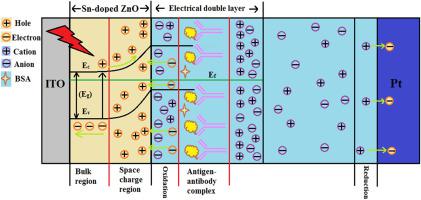Colloids and Surfaces A: Physicochemical and Engineering Aspects ( IF 5.2 ) Pub Date : 2021-09-23 , DOI: 10.1016/j.colsurfa.2021.127586 Tanveer ul Haq Zia 1 , Anwar ul Haq Ali Shah 1

|
Photoelectrochemical (PEC) based immunosensors are important bioanalytical tools for the label free detection of hepatitis C (HCV) antibodies as the photocurrent in the external circuit which is the response signal is not effected intrinsically by the excitation stimulus of light. Therefore, in this article, the facile development of label-free photoelectrochemical (PEC) immunosensor for the detection of hepatitis C (HCV) anticore mAbs 19D9D6 (1 NLB monoclonal antibodies) is reported. The photoactive ZnO was applied as matrix which was further doped with Sn in order to enhance the PEC properties for constructing the PEC immunosensor through immobilization of truncated recombinant HCV core nucleocapsid polypeptide antigen (residues 13–40) corresponding to immunodominant region as biolayer for immunospecific interaction. Morphological analysis was carried out using Scanning electron microscopy (SEM). X-ray diffraction (XRD) was performed for the structural analysis of the pure ZnO and Sn doped ZnO matrix. Optical properties were evaluated using the UV–visible spectroscopy that was further used to attain Mott–Schottky plot, Tauc plot and Urbach plot that explained in detail the PEC enhancement in terms of the energy band gap (Eg). The results depicted a significant red shift in the light absorption by Sn-doped ZnO electrode due to band shrinkage. Defect sites induced due to doping also hinders the photo-generated electron-hole pair recombination. Consequently, the photocurrent density of Sn doped ZnO electrode increased approximately two fold when subjected to illumination. The insulative layer formation at the semi-conductor solution junction resulted in a significant decrease in the photocurrent density that was successfully applied to monitor the immunospecific interaction between the antigen and antibody. PEC immunosensor has the linear detection range from 0.006 to 60 ng mL-1 anticore mAbs 19D9D6 (1 NLB monoclonal antibodies) concentration with 0.53 pg mL-1 (S/N = 3) detection limit as a function of photocurrent decrement which is low for enhancing the sensitivity to effectively measure the antibody. The as prepared PEC immunosensor displayed high selectivity and stability due to which it can be rendered as capable photoelectrochemical scheme for protein detection in the point of care medical diagnosis.
中文翻译:

基于Sn掺杂ZnO敏感光催化表面的无标记光电化学免疫传感器用于检测丙型肝炎(HCV)抗核心mAbs 19D9D6
基于光电化学 (PEC) 的免疫传感器是用于无标记检测丙型肝炎 (HCV) 抗体的重要生物分析工具,因为作为响应信号的外部电路中的光电流本身不受光激发刺激的影响。因此,在本文中,报告了用于检测丙型肝炎 (HCV) 抗核心 mAbs 19D9D6(1 NLB 单克隆抗体)的无标记光电化学 (PEC) 免疫传感器的简易开发。将光敏 ZnO 作为基质应用,并进一步掺杂 Sn,以通过固定与免疫显性区相对应的截短重组 HCV 核心核衣壳多肽抗原(残基 13-40)作为免疫特异性相互作用的生物层来增强 PEC 特性,以构建 PEC 免疫传感器. 使用扫描电子显微镜(SEM)进行形态学分析。使用 X 射线衍射 (XRD) 对纯 ZnO 和掺杂 Sn 的 ZnO 基体进行结构分析。使用紫外-可见光谱评估光学特性,该光谱进一步用于获得 Mott-Schottky 图、Tauc 图和 Urbach 图,这些图详细解释了 PEC 在能带隙方面的增强。Ë g ^)。结果表明,由于能带收缩,Sn 掺杂的 ZnO 电极的光吸收发生了显着的红移。由于掺杂引起的缺陷位点也阻碍了光生电子-空穴对复合。因此,当受到照射时,Sn 掺杂的 ZnO 电极的光电流密度增加了大约两倍。在半导体溶液连接处形成的绝缘层导致光电流密度显着降低,这已成功应用于监测抗原和抗体之间的免疫特异性相互作用。PEC 免疫传感器的线性检测范围为 0.006 至 60 ng mL -1 anticore mAbs 19D9D6(1 NLB 单克隆抗体)浓度为 0.53 pg mL -1(S/N = 3) 检测限是光电流衰减的函数,其较低以提高灵敏度以有效测量抗体。所制备的 PEC 免疫传感器显示出高选择性和稳定性,因此它可以作为有效的光电化学方案用于即时医疗诊断中的蛋白质检测。



























 京公网安备 11010802027423号
京公网安备 11010802027423号